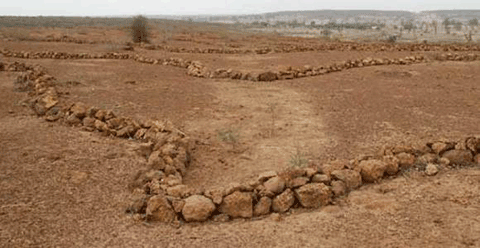Regenerative Agriculture: The Transition.
11 Sep, 2009 08:30 am
In the face of peak oil and in order to curb carbon emissions, methods of farming that depend less on oil and natural gas, respectively to run machinery and to make synthetic fertilizers, must be sought. Such options are to be found within the framework of regenerative agriculture, but the transition from current industrialised agriculture to these alternative strategies will prove testing.
 |
| Kissane region, Senegal |
I have spoken about regenerative agriculture and permaculture, in which most of the energy involved in running them is provided quite naturally by native soil fauna fed ultimately by photosynthesis, since the fuel for good soil derives from plants as the factories that supply carbon-rich nutrients and in a wonderful symbiosis, the living soil microbes, especially fungi can draw other nutrients and water from the soil to nourish the plants. The individual elements of life feed one another in a mutually dependent and beneficial manner.
While the two scenarios can be defined and envisaged rather clearly, the intermediate means for transition from industrial to regenerative agriculture is rather more nebulous, since it has not been done before, or at least not in the degree that necessity now demands. So how might we perform this revolution in the least painful way?
For a start, a decolinising and restructuring of present industrialised agriculture is necessary along with an appreciation and magnification of native and traditional food systems. Overall, a change in thinking and concept is required from conflict and limit to cooperation and abundance.
The scale of the transition may be compared with other milestone transitions throughout human history, such as the hunter-gatherers becoming farmers, and then modern industrial societies. It is the latter that are under threat and unsustainable, and a compromise devolution to a more localised collective of small communities (pods) is required, supplied by local farms and infrastructure with rail links between them for essential movement of goods and people. The maintenance of the Internet and electronic communications would seem desirable since ideas and knowledge can be transmitted from pod to pod and between countries and continents.
In the 1970s, there were studies done that evaluated the massive inefficiency in energy requirements for food production. It was concluded that 10 Calories of energy are expended to bring 1 calorie of food onto the dinner plate. It has been stressed that essential agricultural production is to yield food and fibre - i.e. the essential elements of biomass. One might also add-in fuel as a product, if the consideration also includes fermentation of sugars form starch into ethanol, or hydrothermal production of liquid and gaseous fuels from biomass by heating it under pressure in the presence of water.
The impending stress of "climate change" is well acknowledged, e.g. sea-level rise and the spreading desertification of formerly green lands, but its impact on agriculture is rarely mentioned by climate-modellers. However, as a for-instance, it is speculated that the Colorado River basin could dry up. It's mighty dams would then look something like the pyramids of Egypt, maybe leaving future generations to speculate as to what their purpose was, and upon the nature of the civilization that created them. As climate zones shift, it is the variability of the weather that will have greater impact than ramping "mean temperatures" on the enormous investment made by humans in agriculture. The capital outlays required for new dams, irrigation supplies and the retraining of farmers will need to be contrasted with that for flood-defences in vulnerable locations (e.g. New Orleans and the east coast of England). Most likely both cannot be supported and it may prove expedient to simply let some regions "go to the sea".
Biodiversity is a natural means for evening-out the gains and losses of of living system. It is cooperative in the sense that pests are not encouraged as they are by growing single strains of crop, and that suitably matched plants help each other to grow - the holistic whole being more robust than the simple measure of its components. The term "global village" tends to signify an interconnected unity of trade or electronic communication, while aspects of cultural diversity and biodiversity seldom enter the line of thinking. However, it is a necessity to preserve and expand the traditional food and fibre production systems that are tried and tested and whose regenerative capabilities have been demonstrated over millennia. We may adapt to or readopt cultures that have been lost, as industrial civilization has supplanted them, and it is the latter that we must seek to break away from to arrive at a sustainable future, if we are to survive as a human species that is.
If "global village" means "global supermarket", the term lends acceptance to the concomitant rule of multinational corporations. If we restructure societies to become self-sustaining, rather than dependent on inputs and indeed outputs, as they are now, we also must abandon "limited liability" and the legal designation of "corporations" as "persons" with the same rights as individual citizens. Traditional food systems are storehouses both of biodiversity and cultural diversity. It is a pity that the seedbanks around the world contain no information about the culture, economy, details of cultivation methods, flavour or other human aspects of the crops and the food they produce. Including my own musings on the topic, most commentators on the post peak oil world refer to the need to localise food systems, such that small populations are provided for locally by means of community farms. However, establishing regenerative systems to grow food and fibre must include cities too, the design of which must be analysed in terms of the natural mechanisms that interweave them.
It is mostly not realised that the rural development or redevelopment urged by the industrialised nations for the developing world are precisely those they need to adopt themselves. E.F.Schumacher's "Buddhist Economics" which he describes in the bestselling "Small is Beautiful - A Study of Economics as if People mattered", applies equally to the industrialised world as it must of needs de-industrialise, and take lessons from simpler societies which consume far less per head of population. The example of Cuba may be taken as a benchmark for progress, as it has survived and indeed thrived through implementing a system of community gardens, in the abrupt absence of cheap and plentiful oil and fertilizers gifted from the Soviet Union when its regime collapsed in 1989.
We can mention too the Gaia hypothesis of James Lovelock, which has acted as an iconic beacon to the environmental movement, drawing-in a range of people dissatisfied with the industrial and materialistic way of life, and who seek alternative, more natural and or spiritually rewarding lifestyles, and with less detriment to the planet and life upon it. "Gaia" is holistic in nature and is based on ecology. Rather than an indstrialised "global village" it implies a "globe of villages". Food and fibre production is one of the most important features of the transition to a post-fossil fuel era, to which the establishment of regenerative food systems is essential.
Related Reading.
K.A.Dahlberg, "A Transition From Agriculture to Regenerative Food Systems," Futures, (1994), 26(2), 170-179.
-
12/12/12
ÂPeak Oil is Nonsense Because ThereÂs Enough Gas to Last 250 Years.
-
05/09/12
Threat of Population Surge to "10 Billion" Espoused in London Theatre.
-
05/09/12
Current Commentary: Energy from Nuclear Fusion  Realities, Prospects and Fantasies?
-
04/05/12
The Oil Industry's Deceitful Promise of American Energy Independence
-
14/02/12
Shaky Foundations for Offshore Wind Farms







 Read more
Read more